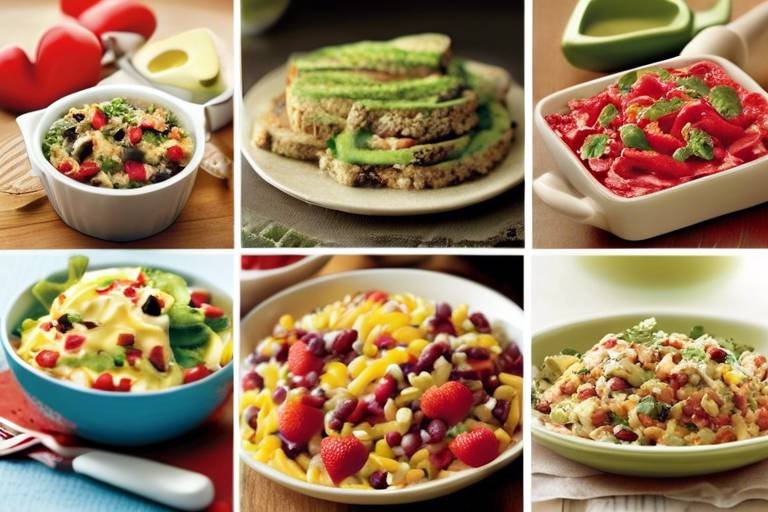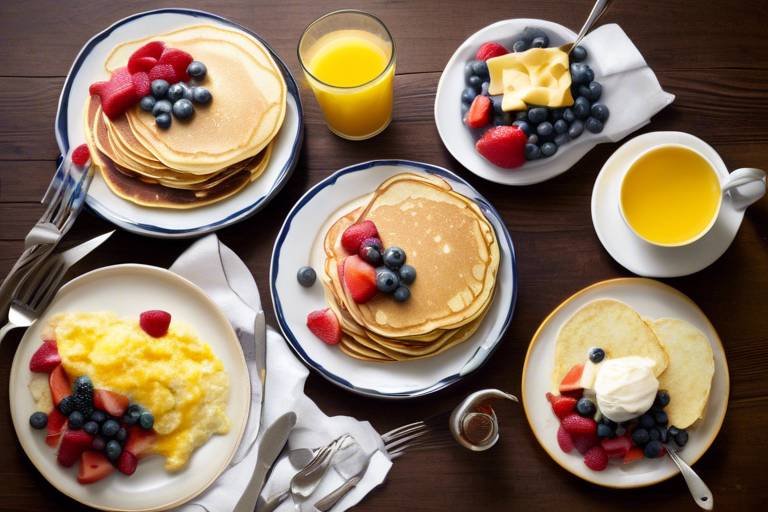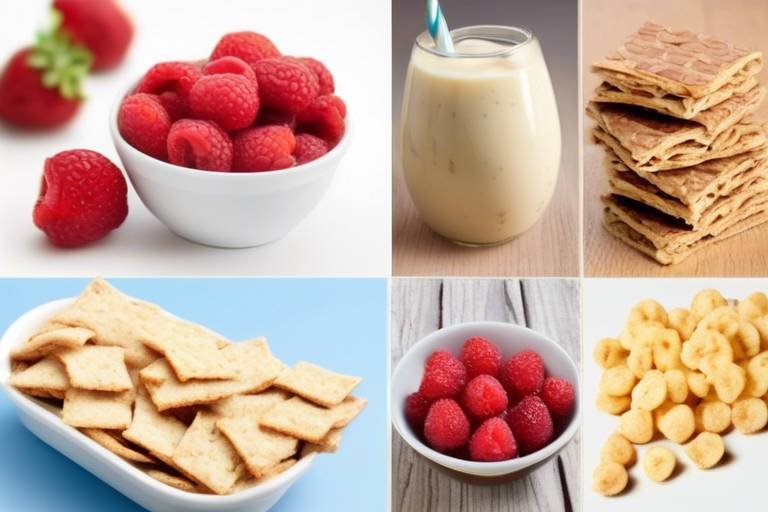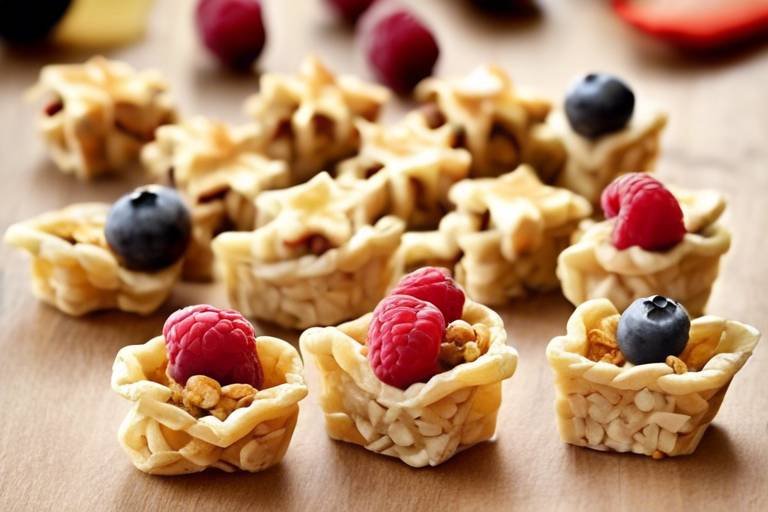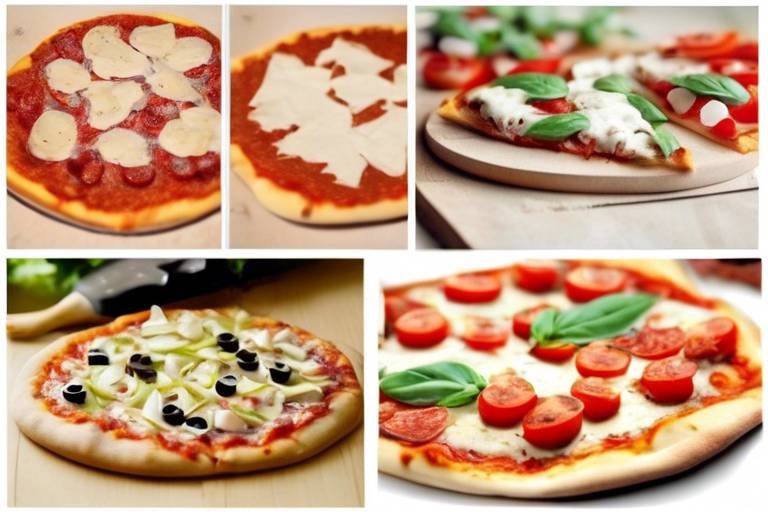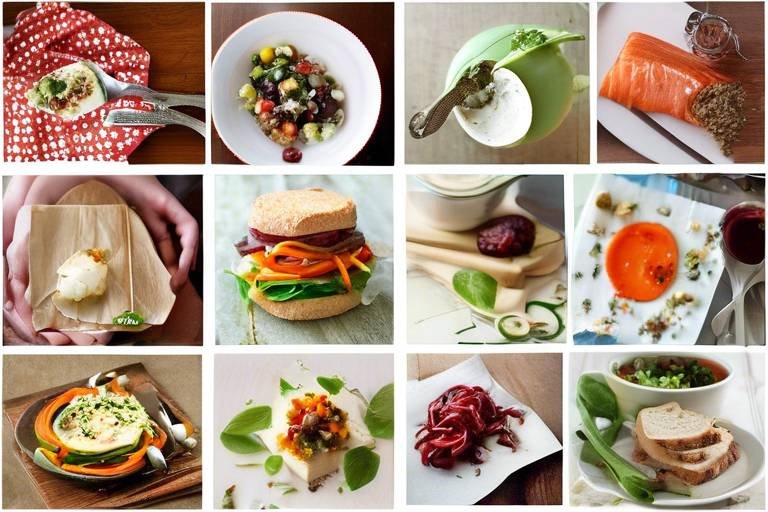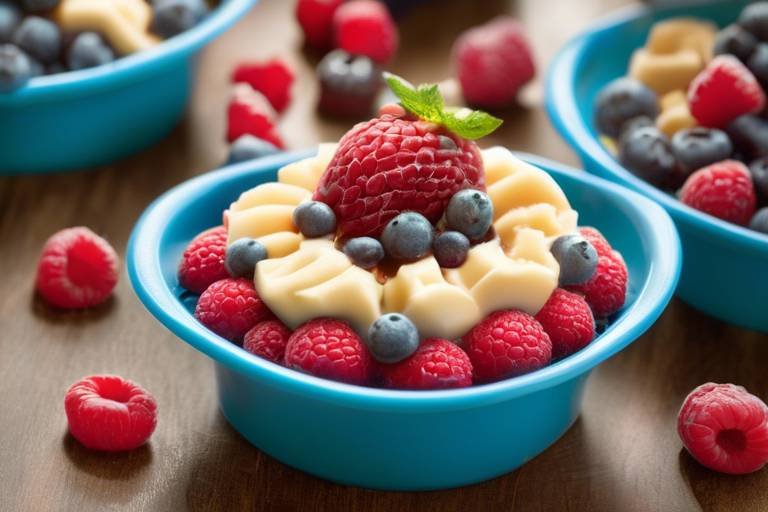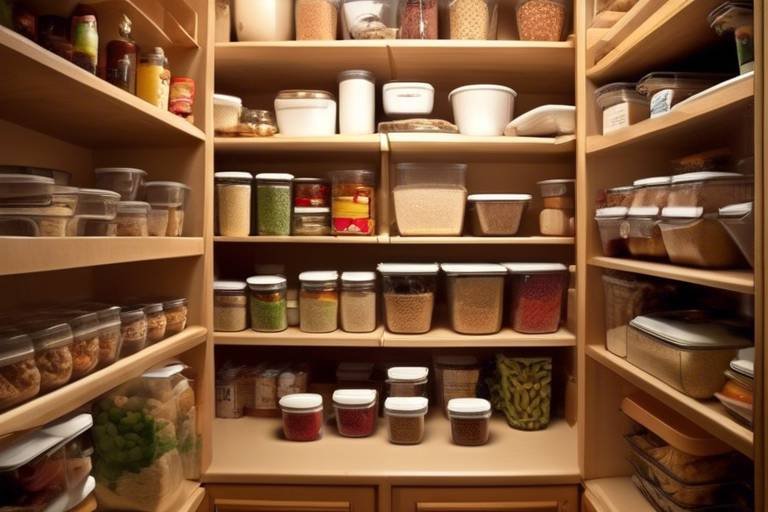Snack Meal Prep: A Week of Healthy Options for Kids
In today’s fast-paced world, healthy eating can often take a backseat, especially when it comes to feeding our kids. But what if I told you that with a little planning and creativity, you can transform snack time into an exciting adventure? Welcome to the world of snack meal prep! This article explores nutritious and delicious snack ideas for kids, providing meal prep tips and recipes that make healthy eating easy and enjoyable throughout the week. Imagine a week where your kids eagerly anticipate snack time, not just for the taste but for the fun and variety that comes with it!
Meal prepping is like having a secret weapon in your parenting toolkit. Not only does it save precious time during busy weekdays, but it also encourages healthier eating habits in children. Think about it: when snacks are planned in advance, you’re less likely to reach for unhealthy options. Instead, you can offer balanced nutrition that fuels their bodies and minds. Here are some key benefits:
- Time-Saving: Spend less time in the kitchen during the week.
- Healthier Choices: Control ingredients and portion sizes.
- Variety: Introduce a wide range of foods to keep things interesting.
- Involvement: Get your kids involved in the preparation process, making them more likely to enjoy what they eat.
When it comes to creating healthy snacks, knowing the right ingredients is crucial. Think of these ingredients as the building blocks of delicious, nutritious snacks that your kids will love. Here are some essentials to stock up on:
- Fruits: Fresh, frozen, or dried, fruits are versatile and packed with vitamins.
- Vegetables: Crunchy and colorful, they provide fiber and essential nutrients.
- Whole Grains: Oats, whole grain bread, and crackers offer sustained energy.
- Proteins: Nut butters, yogurt, and cheese are great for growth and development.
Fruits and vegetables are vital for children's growth and development. Not only do they provide essential vitamins and minerals, but they also add color and fun to snack time. To make these nutritious options more appealing, consider creative ways to incorporate them into snacks that kids will love. For instance, you can create colorful fruit skewers or vegetable faces on whole grain crackers. The key is to make them visually appealing and fun!
Mixing different fruits can create exciting flavor combinations that keep snack time interesting. Here are a few suggestions:
- Berry Medley: Combine strawberries, blueberries, and raspberries for a vibrant mix.
- Tropical Twist: Pair mango, pineapple, and kiwi for a taste of the tropics.
- Citrus Delight: Mix oranges, grapefruit, and lemon slices for a refreshing zing.
Let’s face it, veggies can be a tough sell sometimes. But with the right dips, they can become irresistible! Explore healthy dip recipes that make eating vegetables fun and delicious for children. For example, a creamy hummus or a tangy yogurt dip can turn carrot sticks and cucumber slices into a snack that kids can't resist.
Whole grains and proteins are essential for sustained energy and growth. They help keep little bellies full and satisfied. Integrating these into quick and easy snacks for kids can be a breeze. Think whole grain wraps filled with turkey and cheese, or oatmeal energy balls that combine oats, nut butter, and honey. These snacks not only taste great but also provide the nutrients kids need to thrive.
Now that we've covered the essentials, let's dive into some simple and healthy snack recipes that are perfect for kids. These recipes can be prepared in advance, making them a go-to option for busy parents. Plus, they’re sure to please even the pickiest of eaters!
No-bake energy bites are a quick and nutritious snack option. They’re super easy to make and can be customized based on your kids’ preferences. Here’s a basic recipe to get you started:
Ingredients: - 1 cup oats - 1/2 cup nut butter - 1/3 cup honey - 1/2 cup chocolate chips or dried fruits Instructions: 1. Mix all ingredients in a bowl. 2. Roll into small balls and refrigerate for an hour. 3. Enjoy as a quick snack!
Yogurt parfaits are not only delicious but also packed with nutrients. Layer yogurt with fruits and granola for a tasty treat that kids will love. You can even let them get creative by choosing their own toppings!
Proper storage is crucial for keeping snacks fresh and accessible. Discover effective organization strategies to streamline your snack prep process. By keeping everything organized, you make it easier for your kids to grab healthy snacks on their own.
Choosing the right containers can make a big difference in snack prep. Opt for clear containers so kids can easily see their options. Portioning snacks into individual servings can also help with portion control and reduce waste.
Labeling snack containers can simplify meal times. Use fun labels or color coding to help your kids quickly identify their favorite snacks. This not only makes it easier for them to choose but also encourages independence during snack time.
Q: How can I get my kids involved in meal prepping?
A: Involve them in choosing snacks, prepping ingredients, and even assembling their own snack boxes. Making it a fun activity will encourage them to try new foods!
Q: What are some good snacks for picky eaters?
A: Try to offer a variety of textures and flavors. Smoothies, fruit popsicles, and homemade granola bars are often hits with picky eaters.
Q: How long can prepped snacks last in the fridge?
A: Most prepped snacks can last about 3-5 days in the fridge. Just be sure to check for freshness before serving!

Benefits of Meal Prepping for Kids
When it comes to nurturing healthy eating habits in children, meal prepping stands out as a game-changer. Imagine this: a busy week ahead filled with school, sports, and playdates. The last thing you want is to scramble for snacks that are both nutritious and appealing. By preparing meals in advance, you not only save precious time but also set the stage for your kids to develop a preference for healthier choices. It's like giving them a treasure map to discover the world of wholesome eating!
One of the most significant benefits of meal prepping is the opportunity it provides to teach kids about balanced nutrition. When you involve them in the process of selecting and preparing snacks, it becomes an educational adventure. You can explain the importance of different food groups, helping them understand why fruits, vegetables, whole grains, and proteins are essential for their growth. This hands-on approach can spark their curiosity and make them more likely to try new foods.
Additionally, meal prepping can help reduce food waste. By planning snacks ahead of time, you can ensure that you're using ingredients that you already have on hand, minimizing the chances of spoilage. This not only saves money but also encourages kids to appreciate the value of food. When they see how meals are made from fresh ingredients, they may develop a stronger connection to their meals, leading to more mindful eating habits.
Another noteworthy advantage is that meal prepping fosters independence in children. When they know that healthy snacks are readily available, they can make choices on their own, promoting autonomy. Imagine your child confidently reaching for a pre-portioned fruit cup or a homemade energy bite instead of a sugary treat. This sense of independence can boost their self-esteem and help them make better food choices as they grow.
In summary, the benefits of meal prepping for kids are multifaceted:
- Saves time during busy weeks
- Encourages healthier eating habits
- Teaches kids about balanced nutrition
- Reduces food waste and saves money
- Promotes independence and decision-making skills
So why not embark on this meal prepping journey? It’s not just about the snacks; it’s about creating a lifestyle that celebrates health, creativity, and fun in the kitchen!

Essential Snack Ingredients
When it comes to preparing healthy snacks for kids, the right ingredients are key. Choosing nutritious options not only fuels their bodies but also supports their growth and development. So, what should you stock up on? First and foremost, you'll want to focus on whole foods that are rich in vitamins, minerals, and other essential nutrients. Think of these as the building blocks of a balanced snack.
One of the best ways to ensure your kids are getting a variety of nutrients is to incorporate a range of fruits and vegetables. These can be fresh, frozen, or even dried, making them versatile options for any snack. For example, fruits like bananas, apples, and berries are not only sweet and delicious but also packed with fiber and antioxidants. Vegetables like carrots, cucumbers, and bell peppers can add crunch and color to any snack plate, making it visually appealing to young eaters.
Next up, we have whole grains. Whole grain snacks provide lasting energy and are a fantastic source of fiber. Consider options like whole grain crackers, popcorn, or oatmeal. These can be easily paired with other ingredients to create satisfying snacks. For instance, whole grain crackers topped with hummus or peanut butter can be both filling and nutritious.
Don’t forget about protein sources! Protein is crucial for growth, and it helps keep kids feeling full longer. Nut butters, Greek yogurt, cheese, and even hard-boiled eggs are excellent choices. For a fun twist, try making a yogurt parfait by layering Greek yogurt with fruits and a sprinkle of granola. This not only adds flavor but also a good dose of protein and healthy fats.
Finally, let's talk about healthy fats. Incorporating fats from sources like avocados, nuts, and seeds can make snacks more satisfying and nutritious. For example, a handful of mixed nuts or a slice of avocado on whole grain toast can provide both flavor and essential fatty acids that are vital for brain development.
In summary, when prepping snacks for your little ones, focus on the following essential ingredients:
- Fruits and Vegetables: Fresh, dried, or frozen
- Whole Grains: Crackers, popcorn, oatmeal
- Proteins: Nut butters, Greek yogurt, cheese
- Healthy Fats: Avocados, nuts, seeds
By keeping these ingredients on hand, you can easily whip up a variety of snacks that are not only delicious but also packed with the nutrients kids need to thrive. Remember, the goal is to make healthy eating fun and enjoyable, so get creative and involve your kids in the snack prep process!

Fruits and Vegetables
When it comes to healthy snacks for kids, fruits and vegetables are the unsung heroes. These colorful edibles are not just packed with essential vitamins and minerals; they also bring a burst of flavor and fun to snack time. Imagine a snack that not only satisfies hunger but also fuels your child’s growth and development! Sounds appealing, right? Incorporating fruits and veggies into your child's diet can be as easy as pie—or should we say, as easy as a fruit salad?
One of the best ways to engage kids with fruits and vegetables is by making them visually appealing. Think about it: a plate filled with vibrant colors is much more enticing than a dull one. You can create fruit kabobs using skewers, threading pieces of strawberries, bananas, and grapes together for a fun, edible art project. Or, how about a rainbow vegetable platter? Cut up bell peppers, carrots, cucumbers, and cherry tomatoes, and arrange them in a way that resembles a rainbow. Kids will love the creativity, and you’ll love the nutrition!
Another fantastic idea is to incorporate fruits and vegetables into dips. For instance, you can blend up some avocado to make a creamy dip or mix Greek yogurt with herbs for a tasty veggie dip. Not only does this make veggies more appealing, but it also adds a protein punch! Kids often enjoy the act of dipping, and it can turn a simple carrot stick into a fun and interactive snack. You might even catch them sneaking in a few extra veggies just for the dip!
Here are some fruits and vegetables that are particularly popular with kids:
- Fruits: Apples, bananas, berries, and oranges
- Vegetables: Carrots, cucumbers, bell peppers, and cherry tomatoes
Incorporating these choices into your meal prep can lead to more balanced nutrition. You can easily prepare a week's worth of snacks by cutting up fruits and vegetables and storing them in clear containers in the fridge. When kids can see their healthy options, they are more likely to choose them over less nutritious snacks. Plus, you can add a little excitement by rotating the fruits and veggies each week, keeping snack time fresh and fun!
Remember, the goal is to make healthy eating an enjoyable experience. The more you can involve your kids in the process—whether it’s picking out fruits at the grocery store or helping to prepare snacks—the more likely they are to embrace these healthy choices. So, let’s get those fruits and veggies on the snack menu and watch our kids thrive!

Fun Fruit Combos
When it comes to keeping snack time exciting for kids, are a game-changer! Mixing different fruits not only adds a splash of color to the plate but also introduces a variety of flavors that can make even the pickiest eaters excited about healthy snacking. Imagine a vibrant fruit salad bursting with juicy strawberries, refreshing watermelon, and sweet pineapple. The key is to combine textures and tastes that appeal to children’s adventurous side while sneaking in essential nutrients. Here are some delightful and creative fruit pairings that are sure to please:
- Berry Banana Bliss: Combine sliced bananas with strawberries and blueberries for a sweet, antioxidant-packed treat. Drizzle with a little honey for extra sweetness!
- Tropical Twist: Mix chunks of mango, pineapple, and kiwi for a refreshing tropical escape. This combo is not only delicious but also rich in vitamins.
- Apple and Peanut Butter Delight: Slice up some apples and serve them with a side of peanut butter or almond butter. This combo provides a satisfying crunch and a protein boost!
- Melon Medley: Combine cantaloupe, honeydew, and watermelon for a hydrating snack that’s perfect for hot days. Add a sprinkle of lime juice for a zesty kick!
These combinations are not just tasty; they also provide a variety of vitamins and minerals that are crucial for your child's development. For instance, berries are rich in antioxidants, while bananas provide potassium, which is essential for muscle function. The best part? You can get creative! Let your kids help in the kitchen by choosing their favorite fruits and creating their own unique combos. This not only makes them more likely to eat their snacks but also encourages them to explore new flavors and textures.
In addition to traditional fruit combinations, consider adding some fun textures to your fruit snacks. For example, you can freeze grapes for a cool treat on a hot day or make fruit kabobs with chunks of various fruits on skewers. This hands-on approach makes snacking an interactive experience that kids will love!
So, the next time you’re prepping snacks for the week, don’t forget to mix and match fruits in exciting ways. With a little creativity, you can turn ordinary fruit into an extraordinary snack that’s both nutritious and fun!
Q: How can I encourage my kids to eat more fruits?
A: Getting kids involved in choosing and preparing fruits can spark their interest. Offer a variety of colorful fruits and let them create their own fruit salads or kabobs.
Q: Are frozen fruits as nutritious as fresh fruits?
A: Yes! Frozen fruits are often picked at their peak ripeness and flash-frozen, preserving their nutrients. They can be a convenient and healthy option, especially for smoothies or snacks.
Q: What are some good fruits for meal prep?
A: Fruits like apples, bananas, berries, and grapes are great for meal prep. They can be pre-sliced or portioned out for easy grab-and-go snacks throughout the week.

Veggie Dips
Getting kids to eat their vegetables can sometimes feel like pulling teeth. However, the right dips can transform those crunchy veggies into a fun and exciting snack that kids will actually enjoy! Think of veggie dips as the magic wands that turn boring broccoli into a delightful treat. Not only do they make veggies tastier, but they also encourage kids to explore different flavors and textures.
When it comes to creating veggie dips, the possibilities are endless. You can go from classic ranch dressing to creamy hummus, or even a zesty guacamole. The key is to keep it simple and flavorful. Here are a few popular dip ideas that can elevate snack time:
- Hummus: A chickpea-based dip that’s rich in protein and fiber. You can even add flavors like roasted red pepper or garlic to spice things up!
- Guacamole: Perfect for avocados lovers, this dip is creamy and packed with healthy fats. Pair it with carrot sticks or cucumber slices for a refreshing crunch.
- Yogurt-based dips: Mix plain yogurt with herbs and spices for a tangy and nutritious option. Try adding dill for a ranch-like flavor or cumin for a Mediterranean twist.
To make these dips even more appealing, consider presenting them in fun and colorful ways. Use a variety of dipping vessels, like small bowls or even a muffin tin, to create a vibrant snack platter. Arrange an assortment of vegetables like bell peppers, cherry tomatoes, celery sticks, and snap peas around the dips, making it visually enticing for your little ones. Remember, kids eat with their eyes first!
Additionally, you can involve your kids in the preparation process. Let them help chop veggies (with supervision, of course) or mix the dips. This not only makes them more enthusiastic about eating what they've helped create but also teaches them valuable kitchen skills. It’s a win-win situation!
Incorporating veggie dips into your snack routine can make a significant difference in how your kids perceive vegetables. Instead of seeing them as a chore, they’ll start to view them as a fun snack option. So, why not give it a try? Your kids might just surprise you with their newfound love for veggies!
Q: How can I make my veggie dips healthier?
A: You can use Greek yogurt as a base for creamy dips instead of sour cream or mayonnaise. Additionally, incorporating fresh herbs and spices can enhance flavor without adding extra calories.
Q: What vegetables are best for dipping?
A: Crunchy vegetables like carrots, cucumbers, bell peppers, cherry tomatoes, and celery are great choices. They provide a satisfying crunch and pair well with a variety of dips.
Q: Can I prepare veggie dips in advance?
A: Absolutely! Most veggie dips can be made a day or two in advance and stored in the refrigerator. Just be sure to keep them in airtight containers to maintain freshness.

Whole Grains and Proteins
When it comes to fueling our little ones, whole grains and proteins are like the dynamic duo of nutrition! They work together to provide sustained energy and essential nutrients that kids need for their growth and development. Whole grains, such as oats, brown rice, and quinoa, are packed with fiber, which not only aids digestion but also keeps kids feeling full longer. This means fewer snack attacks and more focus on schoolwork or playtime!
Now, let's talk about proteins. They are crucial for building muscles and repairing tissues. Incorporating protein into snacks can help keep kids energized throughout the day. Think of proteins as the building blocks of their bodies. You can find protein in various sources like nuts, yogurt, eggs, and legumes. Imagine a superhero team where whole grains provide the energy and proteins build the strength—together, they create a well-rounded snack!
Here are some easy and delicious ways to incorporate whole grains and proteins into your kids' snack time:
- Whole Grain Crackers with Hummus: These crunchy bites are not only tasty but also provide a great combo of fiber and protein.
- Peanut Butter Oatmeal Balls: A no-bake treat that combines oats and nut butter for a protein-packed energy boost.
- Greek Yogurt with Granola: Layering creamy yogurt with crunchy granola offers a delightful mix of textures and flavors.
By mixing whole grains and proteins into fun snacks, you can create meals that are both nutritious and enjoyable. Plus, kids often love to participate in the preparation process. Involving them in making their own snacks can make them more excited to eat healthy! For instance, let them choose their favorite fruits to add to yogurt or help roll energy bites. It’s a win-win situation—healthy eating becomes a fun activity!
As you plan your weekly snacks, consider creating a snack chart that includes options rich in whole grains and proteins. This not only helps you stay organized but also introduces your kids to new foods they might not have tried before. Here’s a simple example of how you could structure it:
| Snack | Main Ingredients | Benefits |
|---|---|---|
| Peanut Butter Oatmeal Balls | Oats, Peanut Butter, Honey | High in protein and fiber |
| Whole Grain Crackers with Cheese | Whole Grain Crackers, Cheese | Good source of calcium and protein |
| Yogurt Parfaits | Greek Yogurt, Granola, Berries | Rich in probiotics and antioxidants |
In conclusion, by focusing on whole grains and proteins, you not only provide your kids with the nutrients they need but also set the stage for a lifetime of healthy eating habits. So why not get creative in the kitchen and make snack time a little more exciting? Your kids will thank you for it!
Q: How can I ensure my kids are getting enough protein in their snacks?
A: Incorporate protein-rich foods like yogurt, nuts, seeds, and nut butters into their snacks. You can also try adding protein powder to smoothies or baking.
Q: Are whole grains really important for kids?
A: Absolutely! Whole grains provide essential nutrients and fiber that aid digestion and keep kids full longer, helping them maintain their energy levels.
Q: What are some quick snack ideas that include whole grains and proteins?
A: Some quick ideas include whole grain toast with avocado and eggs, yogurt with granola, or a simple trail mix with nuts and whole grain cereal.

Easy Snack Recipes
When it comes to keeping kids happy and healthy, having a repertoire of is essential. Kids can be picky eaters, but with a little creativity, you can whip up snacks that are not only nutritious but also delicious. These recipes are designed to be simple enough to prepare in advance, ensuring that you always have something on hand for those after-school cravings. Let’s dive into some easy-to-make snacks that will keep your little ones fueled and satisfied!
One of the most popular options among kids are No-Bake Energy Bites. These little treats are packed with wholesome ingredients like oats, nut butter, and honey, making them a fantastic source of energy. Plus, they are incredibly versatile! You can customize them with ingredients like chocolate chips, dried fruits, or seeds. Here’s a quick recipe to get you started:
No-Bake Energy Bites Recipe - 1 cup rolled oats - 1/2 cup nut butter (peanut, almond, or sunflower) - 1/3 cup honey - 1/2 cup add-ins (chocolate chips, raisins, or chopped nuts) Instructions: 1. In a bowl, combine all ingredients until well mixed. 2. Roll into bite-sized balls and place on a baking sheet. 3. Refrigerate for at least 30 minutes before serving.
Another crowd-pleaser is the classic Yogurt Parfait. This snack is not only visually appealing but also provides a great balance of protein, carbohydrates, and healthy fats. Layering yogurt with fruits and granola creates a delightful treat that kids will love. You can use any type of yogurt—Greek, dairy, or plant-based—and mix in their favorite fruits. Here’s how to make a simple yogurt parfait:
Yogurt Parfait Recipe - 1 cup yogurt (your choice) - 1/2 cup fresh fruit (berries, bananas, or peaches) - 1/4 cup granola Instructions: 1. In a glass or bowl, layer yogurt, fruit, and granola. 2. Repeat the layers until all ingredients are used. 3. Serve immediately or store in the fridge for later.
Both of these recipes are not only quick to prepare but also offer a great way to sneak in some healthy ingredients. You can even involve your kids in the preparation process! This not only makes cooking fun but also teaches them about nutrition. Remember, the goal is to make healthy eating enjoyable, so feel free to experiment with different flavors and textures.
To keep things organized, consider preparing a batch of these snacks at the beginning of the week. Store them in individual containers so that they are easy to grab when hunger strikes. Not only does this save time during busy weekdays, but it also ensures that your kids have access to healthy options instead of reaching for processed snacks.
In conclusion, with a little planning and creativity, you can create a variety of that cater to your children's tastes while keeping their nutrition in check. These snacks are not only quick to make but also provide the energy and nutrients that kids need for their active lifestyles. So, roll up your sleeves, get cooking, and watch your kids enjoy these tasty treats!
Q1: How can I make snacks more appealing to my kids?
A: Try involving your kids in the snack preparation process. Let them choose their favorite fruits or toppings, and present the snacks in fun, colorful ways. Using cookie cutters to shape fruits or sandwiches can also add a playful touch!
Q2: Can I prepare these snacks in advance?
A: Absolutely! Many of these snacks can be made ahead of time and stored in the refrigerator. Just make sure to use airtight containers to keep them fresh.
Q3: Are these snacks suitable for school lunches?
A: Yes! Both the no-bake energy bites and yogurt parfaits are great options for school lunches. Just make sure to pack them in insulated containers to keep them fresh until lunchtime.

No-Bake Energy Bites
No-bake energy bites are a fantastic snack option for kids that pack a punch of flavor and nutrition without requiring any cooking! These little balls of goodness are not only simple to make, but they’re also customizable, allowing you to cater to your child's taste preferences. Imagine having a delicious snack that you can whip up in just a few minutes and store for the week ahead—sounds like a dream come true, right?
These energy bites typically combine wholesome ingredients such as oats, nut butter, honey, and various mix-ins, making them a powerhouse of energy for active kids. The best part? You can get your little ones involved in the preparation process! Let them mix, roll, and create their own unique combinations. This not only makes snack time fun but also helps them develop a positive relationship with food.
Here are a couple of popular recipes to get you started:
| Recipe Name | Main Ingredients | Prep Time |
|---|---|---|
| Classic Peanut Butter Energy Bites | Oats, Peanut Butter, Honey, Chocolate Chips | 10 minutes |
| Chocolate Coconut Energy Bites | Oats, Almond Butter, Honey, Cocoa Powder, Shredded Coconut | 10 minutes |
To make the classic peanut butter energy bites, simply mix 1 cup of oats, 1/2 cup of peanut butter, 1/3 cup of honey, and 1/2 cup of chocolate chips in a bowl. Roll the mixture into small balls, place them on a baking sheet, and refrigerate for about 30 minutes to set. Voila! You have a delicious snack ready to go!
For the chocolate coconut variation, blend 1 cup of oats, 1/2 cup of almond butter, 1/3 cup of honey, 2 tablespoons of cocoa powder, and 1/4 cup of shredded coconut. Roll them into bite-sized balls and chill. These energy bites are not just tasty; they also provide a great balance of carbohydrates, proteins, and healthy fats, making them perfect for after school or as a pre-sport snack.
Incorporating no-bake energy bites into your weekly meal prep can be a game changer. They are portable, making them easy to toss into a lunchbox or grab as a quick snack on the go. Plus, you can store them in an airtight container in the fridge for up to a week, ensuring you always have a healthy option available. So why not give these energy bites a try? Your kids will love them, and you’ll love how easy they are to make!
Q: Can I use different nut butters in these recipes?
A: Absolutely! Feel free to substitute peanut butter with almond butter, sunflower seed butter, or any other nut butter your kids enjoy.
Q: How can I make these energy bites nut-free?
A: You can replace nut butters with sunflower seed butter or even use mashed bananas or applesauce as a binding agent.
Q: Can I add protein powder to the energy bites?
A: Yes! Adding a scoop of your favorite protein powder can make these bites even more nutritious. Just adjust the other ingredients slightly to maintain the right consistency.

Yogurt Parfaits
When it comes to creating a delicious and nutritious snack for kids, yogurt parfaits are a fantastic option! Not only are they visually appealing, but they also pack a punch of flavor and nutrients in every layer. Imagine a colorful cup filled with creamy yogurt, vibrant fruits, and crunchy granola—it's like a party in a glass! Plus, they are incredibly versatile, allowing you to mix and match ingredients based on what your kids love.
To make a yogurt parfait, start with a base of your favorite yogurt. Greek yogurt is a great choice because it's high in protein, which helps keep little tummies full and satisfied. Then, layer in some fresh fruits—think berries, bananas, or even diced apples. These fruits not only add natural sweetness but also provide essential vitamins and minerals that support your child's growth and development.
Next comes the fun part: adding granola! A sprinkle of granola on top provides a delightful crunch that contrasts beautifully with the smooth yogurt and juicy fruits. You can also get creative with toppings! Consider adding a drizzle of honey for extra sweetness or a sprinkle of cinnamon for a warm, cozy flavor. The beauty of yogurt parfaits is that you can customize them to fit your child's taste preferences, making them a hit every time.
For busy parents, prepping yogurt parfaits in advance can be a game-changer. You can prepare several jars at once and store them in the fridge for quick grab-and-go snacks throughout the week. Just layer the yogurt, fruit, and granola in a jar, seal it tightly, and voilà! You have a healthy snack ready to go. This not only saves time but also encourages kids to reach for something nutritious instead of sugary snacks.
Here’s a quick breakdown of some popular yogurt parfait combinations that your kids might enjoy:
| Yogurt Type | Fruit | Granola |
|---|---|---|
| Greek Yogurt | Strawberries | Honey Almond Granola |
| Vanilla Yogurt | Blueberries | Cinnamon Granola |
| Coconut Yogurt | Banana | Maple Pecan Granola |
In conclusion, yogurt parfaits are not just a snack; they are a fun and healthy way to get your kids excited about eating nutritious foods. With endless combinations and the ability to prep ahead, they fit perfectly into any busy family's routine. So, the next time you're looking for a quick snack idea, consider whipping up some yogurt parfaits. Your kids will love them, and you'll love knowing they're getting a wholesome treat!
Q: Can I use non-dairy yogurt for parfaits?
A: Absolutely! Non-dairy yogurt options like almond or coconut yogurt work great and can be just as delicious.
Q: How long can I store prepared yogurt parfaits?
A: You can store them in the fridge for up to 3 days. Just keep the granola separate if you want it to stay crunchy!
Q: What if my child doesn’t like yogurt?
A: You can substitute yogurt with smoothies or even cottage cheese for a similar texture and taste.
Q: Can I add protein powder to the parfait?
A: Yes! You can mix in protein powder with the yogurt for an extra boost of nutrition.

Storage and Organization Tips
When it comes to snack meal prep, proper storage and organization play a crucial role in keeping your healthy options fresh and accessible. Think of your snack prep as a well-organized toolbox; if everything is in its right place, you can easily grab what you need when hunger strikes. One of the first steps is to choose the right containers. Opt for airtight containers that come in various sizes to accommodate different snacks. For example, small containers are perfect for single servings of yogurt or dips, while larger ones can hold cut fruits or veggie sticks. Consider using glass containers for their durability and eco-friendliness, or BPA-free plastic for lighter options.
Another tip is to label your snacks. Labeling not only helps you quickly identify what's inside each container but also adds a fun element for the kids. You can use colorful stickers or write directly on the containers with a dry-erase marker. This way, children can easily find their favorite snacks without digging through the fridge or pantry, making snack time more enjoyable and less chaotic.
To streamline your snack prep process, think about organizing your snacks by categories. For instance, you could have a section for fruits, another for vegetables, and a space dedicated to whole grains and proteins. This not only makes it easier to grab a snack but also encourages kids to try a variety of healthy options. You might even consider creating a “snack drawer” in the fridge or pantry, where all the healthy snacks are easily accessible. This setup can motivate kids to choose nutritious options over less healthy ones, especially when they can see their choices clearly.
Lastly, don’t forget about the importance of rotation. Just like in a grocery store, make sure to use the “first in, first out” method. When you buy new snacks, place them behind the older ones in your storage area. This ensures that nothing goes to waste and that your kids are always enjoying the freshest snacks available.
- How long can I store prepped snacks?
Most prepped snacks can last in the fridge for up to a week, but always check for freshness. - What type of containers are best for storing snacks?
Airtight glass or BPA-free plastic containers are ideal for keeping snacks fresh. - Can I freeze any of the snacks?
Yes! Many snacks like energy bites and certain fruits can be frozen for longer storage.

Using Containers Wisely
When it comes to meal prepping snacks for kids, choosing the right containers can be a game-changer. Imagine this: you’ve spent time preparing delicious, healthy snacks, but if they’re not stored properly, they can lose their appeal and freshness. The right containers not only keep snacks fresh but also make them easily accessible for busy days. Here are some key considerations to keep in mind when selecting containers for your snack meal prep.
First and foremost, consider material. Containers made from glass or BPA-free plastic are excellent choices. Glass containers are durable, microwave-safe, and often come with airtight lids that help maintain freshness. On the other hand, BPA-free plastic containers are lightweight and less prone to breaking, making them ideal for kids to handle. It's essential to ensure that whatever material you choose is safe for food storage and easy to clean.
Next, think about size and shape. You want containers that are appropriately sized for the snacks you’re preparing. For instance, single-serving containers are perfect for portioning out fruits, yogurt, or veggie sticks. On the flip side, larger containers work well for bulk snacks like trail mix or popcorn. Mixing different sizes can also help create a more organized snack station. Consider stacking options as well; containers that nest together save space and make storage easier.
Now, let’s talk about compartments. Some containers come with dividers, which can be fantastic for keeping different snacks separate. For example, if you’re packing a snack that includes cheese cubes, whole grain crackers, and grapes, a divided container can prevent flavors from mingling while also making it visually appealing for kids. This can encourage them to eat a variety of foods, which is essential for balanced nutrition.
Finally, don't underestimate the power of labels. Having clear labels on your containers can save you time and frustration during busy mornings. You can easily identify what’s inside each container, making it quicker to grab and go. Plus, involving your kids in the labeling process can make them feel more engaged in their snack choices, encouraging them to eat healthier options.
In summary, using containers wisely is about more than just storage; it’s about creating an organized, appealing, and efficient snack prep system. The right containers can make healthy eating an effortless part of your child’s routine. So, next time you’re prepping snacks, take a moment to consider how your choice of containers can enhance the experience for both you and your kids!
- What types of containers are best for meal prepping snacks? Glass and BPA-free plastic containers are ideal as they are durable and safe for food storage.
- How do I keep snacks fresh in containers? Use airtight containers and store them in a cool, dry place. Refrigeration may be necessary for certain snacks.
- Can I use regular kitchen containers for meal prepping? Yes, but ensure they are clean and safe for food storage. Consider using containers specifically designed for meal prep for best results.

Labeling for Easy Access
When it comes to meal prepping, labeling is an often overlooked yet crucial step that can make a world of difference in your kitchen. Imagine opening your fridge or pantry and instantly knowing where everything is. Sounds dreamy, right? By labeling your snack containers, you not only streamline the process of grabbing a quick bite but also help your kids learn about healthy eating habits. It’s like giving them a treasure map to nutritious snacks!
Start by using clear, easy-to-read labels. You can use a label maker, or simply write on masking tape or sticky notes. The key is to ensure that the labels are visible and informative. Include the name of the snack, the date it was prepared, and any important details like “contains nuts” or “gluten-free.” This can be especially helpful for kids with allergies or dietary restrictions.
Consider organizing your snacks by categories. For example, you might have a section for fruits, another for veggies, and a separate area for protein-rich options. You can even color-code your labels for a fun twist! Use bright colors to indicate different food groups, making it visually appealing and easier for kids to pick out their favorite snacks.
Another tip is to involve your children in the labeling process. This not only makes them feel included but also teaches them about the importance of knowing what they eat. You can have fun with it by letting them decorate their own labels. Maybe add a little drawing or sticker that represents the snack inside. This way, they’ll be more excited to grab a healthy option instead of reaching for junk food.
Lastly, don’t forget to regularly review and update your labels. As your kids grow and their tastes change, so will the snacks you prepare. Keeping your labeling system fresh will ensure that your meal prep remains efficient and enjoyable. Plus, it’s a great opportunity to teach your kids about food waste and the importance of eating fresh, healthy meals. Remember, a well-organized kitchen is a happy kitchen!
- Why is labeling important for kids' snacks? Labeling helps kids quickly identify healthy options and teaches them about food choices.
- How can I make labeling fun for my kids? Involve them in the process by allowing them to decorate labels or choose colors.
- What should I include on the labels? Include the snack name, preparation date, and any dietary information.
- How often should I update my labels? Regularly review and update labels as your kids’ tastes change and new snacks are introduced.
Frequently Asked Questions
- What are the benefits of meal prepping snacks for kids?
Meal prepping snacks can save you a ton of time during the week, which is a game changer for busy parents! It also encourages healthier eating habits in kids by making nutritious options readily available. When snacks are prepared in advance, kids are less likely to reach for unhealthy junk food, leading to better overall nutrition.
- What essential ingredients should I include in my kid's snack prep?
Stock up on fruits, vegetables, whole grains, and proteins! These ingredients are not only nutritious but also versatile. Think about items like fresh fruits, colorful veggies, whole grain crackers, nut butters, and yogurt. Mixing and matching these can create exciting and healthy snacks that kids will love!
- How can I make fruits and vegetables more appealing to kids?
Try creating fun fruit combos or pairing veggies with tasty dips! For example, a fruit salad with a mix of colorful fruits can be visually appealing, while adding a yogurt or hummus dip can make veggies more enticing. Kids are more likely to enjoy their snacks when they look fun and delicious!
- Can you suggest some easy snack recipes for kids?
Absolutely! No-bake energy bites are a hit and super easy to make—just mix oats, nut butter, and your choice of add-ins like chocolate chips or dried fruit. Yogurt parfaits are another great option; just layer yogurt with fruits and granola for a tasty treat that’s also packed with nutrients!
- What are the best storage tips for keeping snacks fresh?
Using airtight containers is key to keeping snacks fresh and tasty. Choose containers that are the right size for your snacks to avoid waste. Additionally, labeling containers can help kids easily find their favorite snacks, making mealtime smoother and more organized.
- How can I label snack containers effectively?
Keep it simple! Use clear labels that indicate what’s inside each container. You might even involve your kids in the labeling process—let them decorate their snack containers with fun stickers or drawings. This not only makes it easier to find snacks but also adds a personal touch!





